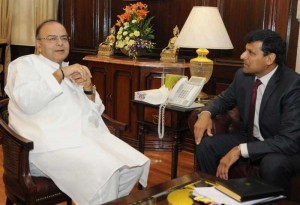 The Iraqi crisis and the possibility of an oil supply shock have shown how quickly things can change in the foreign exchange market. The global macro risks that have merged out of the Middle East in recent weeks have pushed crude prices higher by about five percent and this in turn has led to the rupee breach the all important psychological 60 mark to the dollar.
The Iraqi crisis and the possibility of an oil supply shock have shown how quickly things can change in the foreign exchange market. The global macro risks that have merged out of the Middle East in recent weeks have pushed crude prices higher by about five percent and this in turn has led to the rupee breach the all important psychological 60 mark to the dollar.
While Currency Corner has previously argued that the theme for the rupee still remains gradual depreciation for the rest of the year, a volatile depreciation would certainly put the brakes on the equity market rally and India�s potential macro recovery.
First, let us focus on oil. Till now, both global oil benchmarks have been well-behaved as militant insurgency has not affected the production in the southern parts of Iraq. In a crisis scenario where prices would rally by another $10-$15, India would be in a very vulnerable position. Our import cover has halved to eight months over the past five years – a level not seen since 1998. According to Bank of America, oil imports for FY15 are estimated at 51 percent of FX reserves at $105/bbl. Two data points underscore the rising vulnerability of the falling import cover. Oil imports would have been 64 percent of FX reserves in FY09 had oil averaged $150/bbl. If the annual average oil price blows up to $150/bbl in FY15, oil imports are expected to rise to 78 percent of current FX reserves. Bank of America estimates that the RBI will need to buy $80bn to maintain import cover at eight months. This implies that the RBI would ideally like to recoup FX reserves with the Rs. 58-62/USD range. Further, a $10 increase in the price of oil affects our current account deficit by 0.4 percent of GDP. Another challenge on the CAD front would the decision to ease gold import curbs. Bank of America expects a 2 percent cut in gold import duty. In its view, the government will, sooner rather than later, have to withdraw gold import restrictions as local jewelers run out of inventory. This will likely widen the current account deficit to 2.6 percent from 1.7 percent last year, especially as latent demand could lead to a spike in gold import demand.
Fiscal prudence will also be a key issue in Finance Minister Arun Jaitley’s budget speech (on July 10). Restricting the subsidy bill to below 2 percent of the GDP from the current level of 2.26 percent should be enough to achieve the target of the fiscal deficit being 4.1 percent of the GDP. Remember that this metric is the focus point of rating agencies when gauging our credit worthiness. If indeed there is a global risk of environment with funds flowing from emerging markets to the West, India can face significant bond outflows on the back of a weak debt rating. Social welfare schemes such as the food security bill and MNREGA as well as curbing fertilizer subsidies will be an important potential talking point in the finance minister’s speech. On this point, it is important to remember that these schemes have been argued to be a major factor in rising rural inflation. Mr. Jaitley must also address the bottlenecks which have caused supply side inflation if India is to achieve its target of the consumer price index at 6 percent by 2016.
The upcoming union budget represents the first real challenge to the honeymoon period the newly-elected central government has enjoyed. Mr. Jaitley must present a budget which does not sell the rupee short.